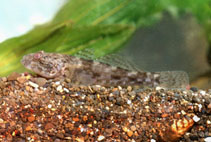Upload your photos and videos
Pictures | Google imagePonticola gorlap
Picture by Naseka, A.M.
Pictures | Google imagePonticola gorlap
Picture by Naseka, A.M.
Classification / Names Nomi Comuni | Sinonimi | Catalog of Fishes(Genere, Specie) | ITIS | CoL | WoRMS | Cloffa
Environment: milieu / climate zone / depth range / distribution range Ecologia
marino; acqua dolce; salmastro demersale. Temperate
Distribuzione Stati | Aree FAO | Ecosystems | Presenze | Point map | Introduzioni | Faunafri
Eurasia: Caspian Sea; in Volga upriver to Astrakhan until 1977, spreaded out to Lakes Ivankovskoje and Rybinskoje (2000); invaded Don drainage (Black Sea basin) through Volga-Don canal (first record in 1972). Abundant in Lake Tsimlyansk and lower Don.
Size / Peso / Age
Maturity: Lm ? range ? - ? cm
Max length : 32.6 cm TL maschio/sesso non determinato; (Ref. 85452); common length : 12.0 cm SL maschio/sesso non determinato; (Ref. 2058)
Max length : 32.6 cm TL maschio/sesso non determinato; (Ref. 85452); common length : 12.0 cm SL maschio/sesso non determinato; (Ref. 2058)
Short description Chiavi di identificazione | Morfologia | Morfometria
This species is distinguished from its congeners in the Caspian Sea basin by the following characters: 75-95 % of distance between its origin and anus; ctenoid scales completely cover predorsal area and nape; pelvic disc fraenum with angular lobes, fraenum length 1/6-1/2 of its width at base; scales in midlateral series 68-72 + 3-4; snout length 1.5-1.6 times in eye diameter; interorbital distance 0.8-0.9 times eye diameter; first branched ray of second dorsal about as long as penultimate ray; posterior part of first dorsal without black spot. This species is different from N. kessleri in the area in having a distinctive karyotype, some osteological characters and cycloid scales on opercle and anterior part of the nape (vs. ctenoid) (Ref. 59043).
Inhabitant of inshore areas, estuaries, brackish and fresh water of lagoons and lakes, large rivers, harbours, on rock (stone or firm sand) bottom; mainly on well vegetated bottom (Ref.13696, 59043). Most females spawn for the first time at 1 year, males at 2 years, in April-May, rarely until July. Adhesive eggs are deposited on stones, shells and aquatic plants and the males guard the eggs after hatching. Feeds mostly on small fish, as well as a wide variety of invertebrates (Ref.59043).
Life cycle and mating behavior Maturità | Riproduzione | Deposizione | Uova | Fecundity | Larve
Main reference
Upload your references | Bibliografia | Coordinatore | Collaboratori
Kottelat, M., 1997. European freshwater fishes. An heuristic checklist of the freshwater fishes of Europe (exclusive of former USSR), with an introduction for non-systematists and comments on nomenclature and conservation. Biologia, Bratislava, 52/Suppl. 5:1-271. (Ref. 13696)
IUCN Red List Status (Ref. 130435: Version 2024-2)
Least Concern (LC) ; Date assessed: 18 April 2022
CITES
Not Evaluated
Threat to humans
Harmless
Human uses
FAO - Publication: search | FishSource |
Informazioni ulteriori
Population dynamics
Growth parameters
Max. ages / sizes
Length-weight rel.
Length-length rel.
Length-frequencies
Mass conversion
Reclutamento
Abbondanza
Growth parameters
Max. ages / sizes
Length-weight rel.
Length-length rel.
Length-frequencies
Mass conversion
Reclutamento
Abbondanza
Life cycle
Riproduzione
Maturità
Maturity/Gills rel.
Fecundity
Deposizione
Spawning aggregations
Uova
Egg development
Larve
Dinamica popolazioni larvali
Riproduzione
Maturità
Maturity/Gills rel.
Fecundity
Deposizione
Spawning aggregations
Uova
Egg development
Larve
Dinamica popolazioni larvali
Anatomy
Area branchiale
Brain
Otolith
Area branchiale
Brain
Otolith
Physiology
Body composition
Nutrients
Oxygen consumption
Swimming type
Swimming speed
Visual pigments
Fish sound
Diseases & Parasites
Toxicity (LC50s)
Body composition
Nutrients
Oxygen consumption
Swimming type
Swimming speed
Visual pigments
Fish sound
Diseases & Parasites
Toxicity (LC50s)
Human related
Aquaculture systems
Profili di acquacoltura
Varietà
Ciguatera cases
Stamps, coins, misc.
Aquaculture systems
Profili di acquacoltura
Varietà
Ciguatera cases
Stamps, coins, misc.
Strumenti
E-book | Giuda pratica | Generatore frequenze di lunghezza | Strumento Parametri Biologici | Mappa dei ritrovamenti | Classification Tree
| Catch-MSY |
Special reports
Download XML
Fonti Internet
AFORO (otoliths) | Aquatic Commons | BHL | Cloffa | BOLDSystems | Websites from users | Check FishWatcher | CISTI | Catalog of Fishes: Genere, Specie | DiscoverLife | ECOTOX | FAO - Publication: search | Faunafri | Fishipedia | Fishtrace | GenBank: genome, nucleotide | GloBI | Google Books | Google Scholar | Google | IGFA World Record | MitoFish | Otolith Atlas of Taiwan Fishes | PubMed | Reef Life Survey | Socotra Atlas | Tree of Life | Wikipedia: Go, ricerca | World Records Freshwater Fishing | Zoological Record
Estimates based on models
Phylogenetic diversity index (Ref. 82804): PD50 = 0.5001 [Uniqueness, from 0.5 = low to 2.0 = high].
Bayesian length-weight: a=0.01259 (0.00634 - 0.02500), b=3.24 (3.08 - 3.40), in cm total length, based on LWR estimates for this species & Genus-body shape (Ref. 93245).
Trophic level (Ref. 69278): 3.8 ±0.4 se; based on diet studies.
Resilienza (Ref. 120179): Medio, tempo minimo di raddoppiamento della popolazione 1.4 - 4.4 anni (Preliminary K or Fecundity.).
Fishing Vulnerability (Ref. 59153): Low vulnerability (23 of 100).




